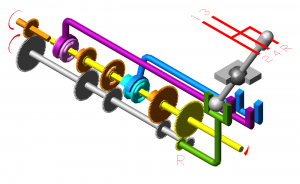 Driving a manual transmission and understanding how it works are 2 completely different matters. Armed with the knowledge of the mechanics of ‘clutch-shift-accelerate/decelerate-etc.’ can certainly help you diagnose potential clutch assembly issues. Besides – it’s great to know what the heck is going on under the hood – right?
Driving a manual transmission and understanding how it works are 2 completely different matters. Armed with the knowledge of the mechanics of ‘clutch-shift-accelerate/decelerate-etc.’ can certainly help you diagnose potential clutch assembly issues. Besides – it’s great to know what the heck is going on under the hood – right?
While automatic transmission is the standard in the automotive industry, when one references ‘standard’ transmission, the reference is to manual or clutch operated driving. This nomenclature stems back to the ‘olden’ days when manual transmission was the standard in the automotive industry. Although there are definite benefits to an automatic transmission; a manual transmission offers:
- More efficient fuel use
- Improved handling
- Very much fun to drive!
There are those that would contest that fuel efficiency and handling are better with clutch driving. But think about it, how many high performance race cars have automatic transmission? That ‘s a discussion for another day…
Clutch Control
As defined so eloquently by Wikipedia:
Clutch control refers to the act of controlling the speed of a vehicle with a manual transmission by partially engaging the clutch plate, using the clutch pedal instead of (or in conjunction with) the accelerator pedal.
When the clutch pedal is compressed completely, there is no contact between the drive shaft and the engine; preventing power being transferred to the drive shaft. With the clutch fully released (disengaged), the clutch plate provides full contact between the driveshaft and the engine; allowing power to be transferred to the vehicle’s wheels.
Common Problems With Clutches
Generally, you can expect a properly maintained clutch to last at least 80,000 miles. On the other hand, it you tend to ‘ride’ your clutch, or if you allow your clutch to ‘slip’, it could need replacement in as little as 35,000 miles. A clutch stops working when the friction material on the disc wears off. This friction material is similar to that of pads on disc brakes. As the friction material wears off the clutch disc, the clutch is unable to grip the flywheel. This inability to grip the flywheel keeps power from transmitting to the drivetrain.
The clutch disc friction material is worn away when the disc and flywheel are rotating at different rotations per minute (rpm’s). When properly engaged, the clutch disc and flywheel are locked together; in this position, the friction material does not wear. In other words, if you ride or slip your clutch a lot, you will wear the friction material off the disc much earlier than should you engage and release properly.
Sticking Clutches
There are mechanical impedances that can cause you clutch to not fully disengage, often rendering your vehicle inoperable:
- Clutch Cable Stretched or Broken: the proper tension is required to move the clutch assembly effectively
- Slave and/or Master Clutch Cylinders Defective: if either the slave or the master clutch cylinders is leaky or otherwise defective, proper pressure cannot be maintained
- Hydraulic Lines: air in the hydraulic lines displaces fluid required to achieve necessary pressure
- Linkage Adjustment: if the linkage is not properly adjusted, the action of pressing the clutch will transmit incorrect force
- Clutch Components: if using aftermarket parts, they may not be compatible with your vehicle’s clutch
Hard Clutching
If your clutch is extremely hard to depress, there are a variety of components that could be at fault:
- Pedal Linkage
- Cross Shaft
- Cable
- Pivot Ball
Additionally, worn hydraulic seals or a blockage can also be the cause of hard clutching.
Regardless the issue you may be having with your clutch, be sure to have it inspected and repaired as soon as possible! The Everett Car Repair and Service Experts in Everett, Lynnwood, Mukilteo, Mill Creek, Lake Stevens, Snohomish, Marysville, Arlington at Conaway Motors are fully certified to handle all your clutching problems.


Great service and great mechanics